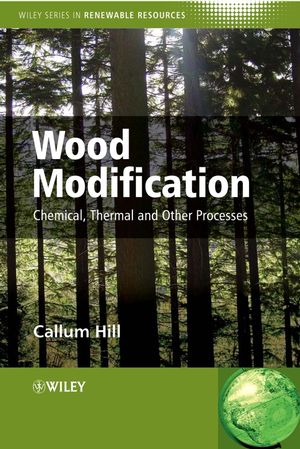Wood Modification: Chemical, Thermal and Other ProcessesISBN: 978-0-470-02172-9
Hardcover
264 pages
February 2006
 This is a Print-on-Demand title. It will be printed specifically to fill your order. Please allow an additional 10-15 days delivery time. The book is not returnable.
|
||||||
Foreword xi
Series Preface xiii
Preface xv
List of Abbreviations xvii
1 The Use of Timber in the Twenty-first Century 1
1.1 Introduction 1
1.2 Nonrenewables: a Finite and Exhaustible Resource 2
1.3 Renewable Materials 4
1.4 The Global Timber Resource 7
1.5 Timber Production 10
1.6 Wood Preservation 11
1.7 Preservative-treated Wood and Legislation 14
1.8 Competition from Nonrenewable Materials 16
1.9 The Need for Wood Modification 17
1.10 Conclusions 17
2 Modifying the Properties of Wood 19
2.1 Introduction 19
2.2 Wood Properties and Wood Modification 19
2.3 Wood Modification Methods 21
2.4 The Cell Wall of Wood 23
2.5 The Chemical Constituents of Wood 25
2.6 The Wood–Water Relationship 30
2.7 The Mechanical Properties of Modified Wood 37
2.8 Modified Wood and Biological Degradation 39
2.9 Wood and Weathering 43
2.10 Proof of Bonding 43
2.11 Conclusions 44
3 Chemical Modification of Wood (I): Acetic Anhydride Modification 45
3.1 Introduction 45
3.2 Reaction Protocols 46
3.3 Cell Wall Reactivity 52
3.4 Analysis of Anhydride-modified Wood 55
3.5 Dimensional Stability 56
3.6 Mechanical Properties 58
3.7 Microbiological Degradation 60
3.8 Biological Degradation by Insects and Marine Organisms 69
3.9 Moisture Relationships of Anhydride-modified Wood 70
3.10 Composites Utilizing Acetic Anhydride Modified Wood 72
3.11 Conclusions 76
4 Chemical Modification of Wood (II): Reaction with Other Chemicals 77
4.1 Introduction 77
4.2 Reaction of Wood with Other Noncyclic Anhydrides 77
4.3 Reaction of Wood with Cyclic Anhydrides 79
4.4 Acetylation Using Ketene Gas 83
4.5 Carboxylic Acid Modification 84
4.6 Acid Chloride Modification 85
4.7 Isocyanate Modification 85
4.8 Epoxide Modification 90
4.9 Alkyl Halide Modification 93
4.10 Aldehyde Modification 93
4.11 Cyanoethylation 96
4.12 Beta-Propiolactone 96
4.13 Quinone Methides 97
4.14 Conclusions 97
5 Thermal Modification of Wood 99
5.1 Introduction 99
5.2 Process Variables 100
5.3 Chemical Changes in Wood due to Thermal Modification 102
5.4 Physical Changes in Wood due to Thermal Modification 110
5.5 Biological Properties of Thermally Modified Wood 123
5.6 Compressed Wood 125
5.7 Oil Heat-treatments 126
5.8 Conclusions 126
6 Surface Modification 129
6.1 Introduction 129
6.2 Surface Chemical Modification for UV Stability 129
6.3 Modification to Render the Wood Surface Hydrophobic 133
6.4 Surface Chemical Modification for Bonding 133
6.5 Enzymatic Modification 143
6.6 Corona or Plasma Discharge 145
6.7 Conclusions 147
7 Impregnation Modification 149
7.1 Introduction 149
7.2 Resin Treatments 150
7.3 Impregnations using Silicon-containing Compounds 162
7.4 Other Inorganic Cell Wall Precipitation Treatments 170
7.5 Cell Wall Impregnation with Monomers 170
7.6 Cell Wall Impregnation with Polymers 171
7.7 Conclusions 173
8 Commercialization of Wood Modification 175
8.1 Introduction 175
8.2 Thermal Modification 175
8.3 Oil Heat Modification/Treatments 182
8.4 Acetylation 183
8.5 Impregnation Modification 188
8.6 Conclusions 190
9 Wood Modification: Environmental Considerations and Future Developments 191
9.1 Introduction 191
9.2 Principles of the Determination of Environmental Impact 192
9.3 Methods of Determining Environmental Impacts 193
9.4 The Environmental Impact of Wood Modification 194
9.5 Industrial Ecology and Wood Modification 194
9.6 The Future of Wood Modification 198
References 201
Index 233



